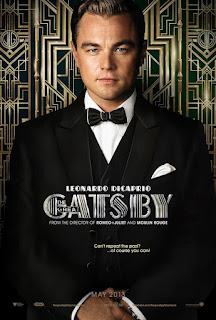Baz Luhrmann is a director that loves the
spectacle of cinema. From the visual, to
the technical, to the audio – it is clear that Baz is a card-carrying cinephile
that caught the bug early in his life.
His early postmodern classics Romeo & Juliet
and Moulin Rouge were
blockbuster events in the cinema calendar and are much loved, yet divisive
films. I have to admit that I am a fan,
even of his pretentious perfume
adverts. He also has a healthy 4-5
year gap between his film releases, which to me signifies a craftsman at
work. The news that he was directing the
Fitzgerald classic was instantly exciting to me…
The narrative of the novel has been much
discussed as a classic example of an unreliable narrator due to the voice being
that of a secondary character and not Gatsby himself. The film keeps this device and introduces us
to Nick Carraway (Tobey Maguire), a New York bond trader who has recently moved
to the nouveau riche area of Long Island.
He lives next door to the extravagant, yet reclusive J. Gatsby; a man
that throws lavish parties but is rarely seen.
Nick gets invited to one of the parties, alongside his flamboyant cousin
Daisy Buchanan who is married to the hyper-rich capitalist Tom. Gatsby takes a liking to Nick and soon
persuades him to reintroduce him to Daisy, thus beginning an affair that leads
to a confrontation with each of the characters and the unwrapping of Gatsby’s
enigmatic past (for more detail, read here).
The film seems to be split into two halves:
the first section as a reminder of the spectacle of Moulin Rouge with big lavish parties in a beautiful art deco house
with quick editing and incredible cinematography; the second half playing out
as a more traditional drama, albeit with more swooping crane shots and CGI.
The one recurring motif that reminds us
that it is a Luhrmann film though is his use of music. Moulin
Rouge was divisive as some people couldn’t stomach show tune-collage
versions of Nirvana and T-Rex songs. In Gatsby he has used popular music in a
different way; instead of the characters singing the songs, the soundtrack adds
a layer of intertextual texture to certain scenes and images. He uses the public persona of Jay-Z and Lana
Del Ray to signify something bigger than the scenes themselves. For example, the extravagant bling that is
attached to Jay-Z and Kanye West add richness to the Art Deco extravagance of
‘20s New York – the city is given a Hip Hop injection.
In 2001 the main musical zeitgeist in
the USA was R&B and Nu-Metal, therefore Moulin
Rouge used Lady Marmalade as its main theme. In 2013 the dominant musical influence is EDM
and dubstep so Luhrmann has used this instead – the only problem is that the
audience’s relationship with music sharing and distribution has increased the
speed of musical relevance. The
overreliance on contemporary music (as opposed to MR’s use of the whole musical
canon) seems exciting as the time but will quickly make this film seem
incredibly dated.
As I was watching The Great Gatsby I couldn’t help but wonder whether this film could
have been released 2/3 years ago in the middle of the financial crisis. It feels like a desperate attempt to remind
Americans of what the really good times can feel like – the lavish parties and
the relentless martinis serve as characters in themselves. The problem with this is that another
reminder that exists in the film is that all of the servants in the film are
black. This may have been a golden time
for capitalism and an era to strive for for a white middle-class audience, but
it should be a reminder that the people who were never invited to the party are
the millions of poor black Americans.

No comments:
Post a Comment